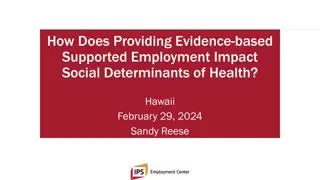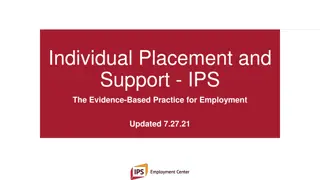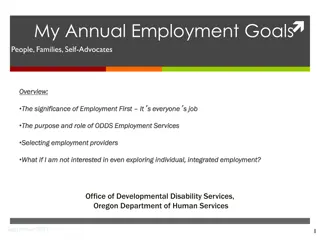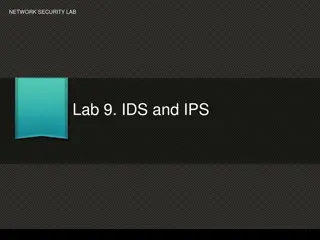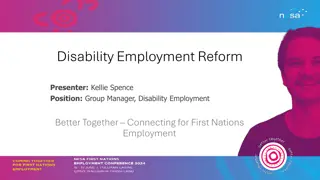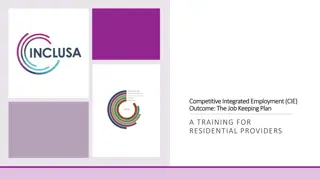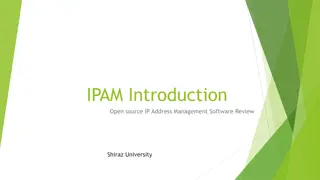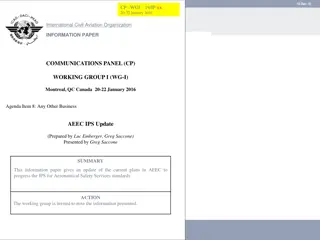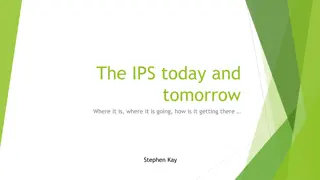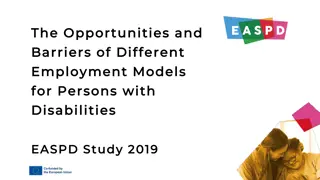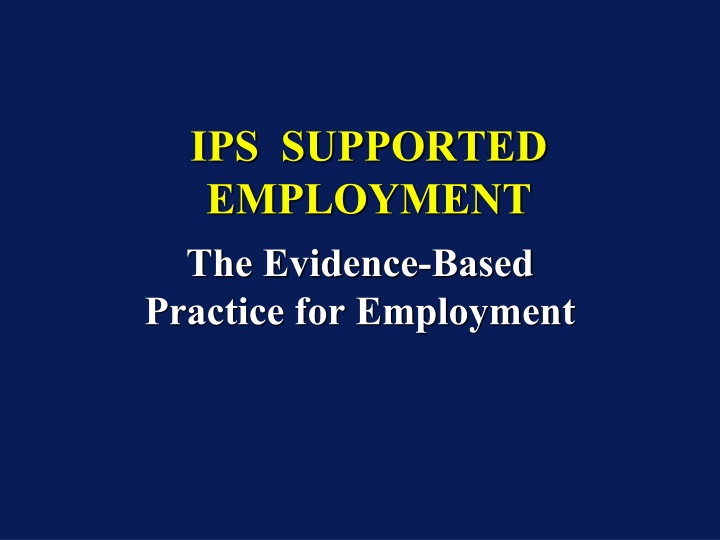
Evidence-Based Practice for Competitive Employment in Mental Health
Discover the benefits of supported employment for individuals with severe mental illness, including increased income, improved self-esteem, and better control of symptoms. Explore why focusing on competitive employment is crucial for recovery, with insights on the negative effects of unemployment. Learn how evidence-based programs can bridge the gap between desire for work and access to services, ultimately improving quality of life for those seeking steady employment opportunities.
Download Presentation

Please find below an Image/Link to download the presentation.
The content on the website is provided AS IS for your information and personal use only. It may not be sold, licensed, or shared on other websites without obtaining consent from the author. If you encounter any issues during the download, it is possible that the publisher has removed the file from their server.
You are allowed to download the files provided on this website for personal or commercial use, subject to the condition that they are used lawfully. All files are the property of their respective owners.
The content on the website is provided AS IS for your information and personal use only. It may not be sold, licensed, or shared on other websites without obtaining consent from the author.
E N D
Presentation Transcript
IPS SUPPORTED EMPLOYMENT The Evidence-Based Practice for Employment
Why Focus on Employment? Viewed by many as an essential part of recovery Most consumers want to work A typical role for adults in our society Cost-effective alternative to day treatment
Benefits of Steady Competitive Employment Increased income Improved self esteem Improved social networks Increased quality of life Better control of symptoms Reduced substance use Reduced use of mental health services
Is Work Too Stressful? As compared to what? Joe Marrone, an employment trainer: If you think work is stressful, try unemployment. Stresses of work do not translate into higher rates of hospitalization
Negative Effects of Unemployment in General Population Increased substance abuse Increased physical problems Increased psychiatric disorders Reduced self-esteem Loss of social contacts Alienation and apathy (Warr, 1987)
Competitive Employment for People with Severe Mental Illness: The Gap Say they want to work: 66% Are currently working: <20% Have access to evidence-based employment services: 2%
Evidence-Based Practice Program model validated by rigorous research (different investigators) Has guidelines describing critical components Has a treatment manual
Quotes from Consumers I feel so much better about myself now that I have a job. Holding down my job is not always easy but it has helped my self esteem. When I go to work I don t hear the voices. Now that I am working again I can buy my daughter presents.
Quotes from Family Members I worried that if my son got a job he would get stressed. But just the opposite happened. He is doing so much better than before. I feel better that she tries working when she has the support of mental health. I was really glad that my son s employment counselor asked me about work ideas. He landed a job that I suggested.
Quotes from Employers Andre is as good as any worker that I have. Automotive parts store manager. I count on Juanita. If she is feeling stressed, she sits in the back room for awhile. That s OK; she gets the job done. Bakery supervisor. The employment counselor helped me understand why Tony paces. It s okay in the security business. Security business owner.
Competitive Employment Rates in 22 Randomized Controlled Trials of IPS
Overall Findings for 22 RCTs All 22 studies showed a significant advantage for IPS Mean competitive employment rates for the 22 studies: 56% for IPS 23% for controls
Definition of Supported Employment Mainstream job in community Pays at least minimum wage Work setting includes people who are not disabled Service agency provides ongoing support Intended for people with most severe disabilities
Evidence-Based Practice Principles Eligibility is based on consumer choice Competitive employment is the goal Supported employment is integrated with treatment Personalized benefits planning is provided Rapid job search is encouraged Employment specialists build employer relationships Follow-along supports are continuous Consumer preferences are important
Eligibility Is Based on Consumer Choice Consumers are not excluded because they are not ready or because of prior work history, hospitalization history, substance use, symptoms, or other characteristics. No one is excluded who wants to participate.
Competitive Employment Is the Goal The agency needs to devote sufficient resources to supported employment to permit full access to all consumers who seek competitive employment Consumers interested in employment are not steered into day treatment or sheltered work.
IPS Is Integrated with Mental Health Treatment Employment specialists coordinate plans with the treatment team, e.g., case manager, therapist, psychiatrist, and other community providers, e.g., Vocational Rehabilitation
Personalized Benefits Planning Is Provided Benefits planning and guidance help consumers make informed decisions about job starts and changes.
Rapid Job Search Is Encouraged Job search starts soon after a consumer expresses interest in working. Pre-employment assessment, training, and counseling are kept to a minimum.
Employment Specialists Build Employer Relationships Employment specialists meet face-to-face with employers over time to learn about business needs and positions. Each specialist makes at least 6 contacts with hiring managers each week.
Follow-Along Supports Are Continuous Employment specialists continue to stay in regular contact with consumer and (when appropriate) the employer without arbitrary time limits.
Consumer Preferences Are Important Job finding is based on consumers preferences, strengths, and work experiences, not on a pool of jobs that are available.
Key Factors in Implementation Build Consensus Maximize Financing Examine Agency Philosophy Identify Leadership Key on Organizational Structure Provide Ongoing Training Make Time Commitment Track Process and Outcomes
Build Consensus Commitment of state mental health authority is not enough Better to involve all stakeholders - consumers, family members, providers, and local and state MH and VR administrators
Maximize Financing Determine how supported employment services can be funded Explore funding through Mental Health, Vocational Rehabilitation, and Medicaid Reallocate resources to supported employment when feasible
What Does IPS Cost? Estimates of per-client annual costs $2500 (Latimer et al., 2004) $4300 (HMC, 2006) $6400 (Cimera, 2007) Adjusting for inflation, 2014 estimates range from $3200 to $7300 Factors affect cost: severity of disability, local wages, indirect costs and which clinical services included
Examine Agency Philosophy Determine if service agency s philosophy, mission statement, and service paradigm are consistent with recovery-oriented, evidence- based approach to IPS supported employment.
Identify Leadership You need a champion! Identify committed leader with sufficient authority to oversee and ensure implementation Leaders at all levels visibly show support for supported employment Center director buy-in is critical Leadership from Vocational Rehabilitation aids collaboration
Leadership Roles Provide necessary resources Seek buy-in from consumers, families, and practitioners Give recognition to staff and consumer for successes Rapp s finding Critical role of supervisor in program success
Organizational Structure Employment specialists Join one or two treatment teams. Share office space with treatment team. Communicate frequently with treatment team members. Team integrates supported employment, benefits counseling, case management, psychiatric services, and dual diagnosis treatment.
Provide Ongoing Training Initial training for all team members, including medical staff Continuing access to expert consultation Ongoing supervision that is outcomes-oriented
Make Time Commitment Typically, 6 - 12 months needed to develop skills, interest, and confidence for implementing evidence- based supported employment
Track Implementation Process and Outcomes Track employment outcomes monthly Set goals: 40% rate of competitive employment is achievable Use the IPS-25, a 25-item supported employment fidelity scale to measure implementation
Summary People with severe mental illness can work in competitive employment Programs following evidence-based principles of supported employment have better outcomes Programs must address financial and organizational barriers to be successful



